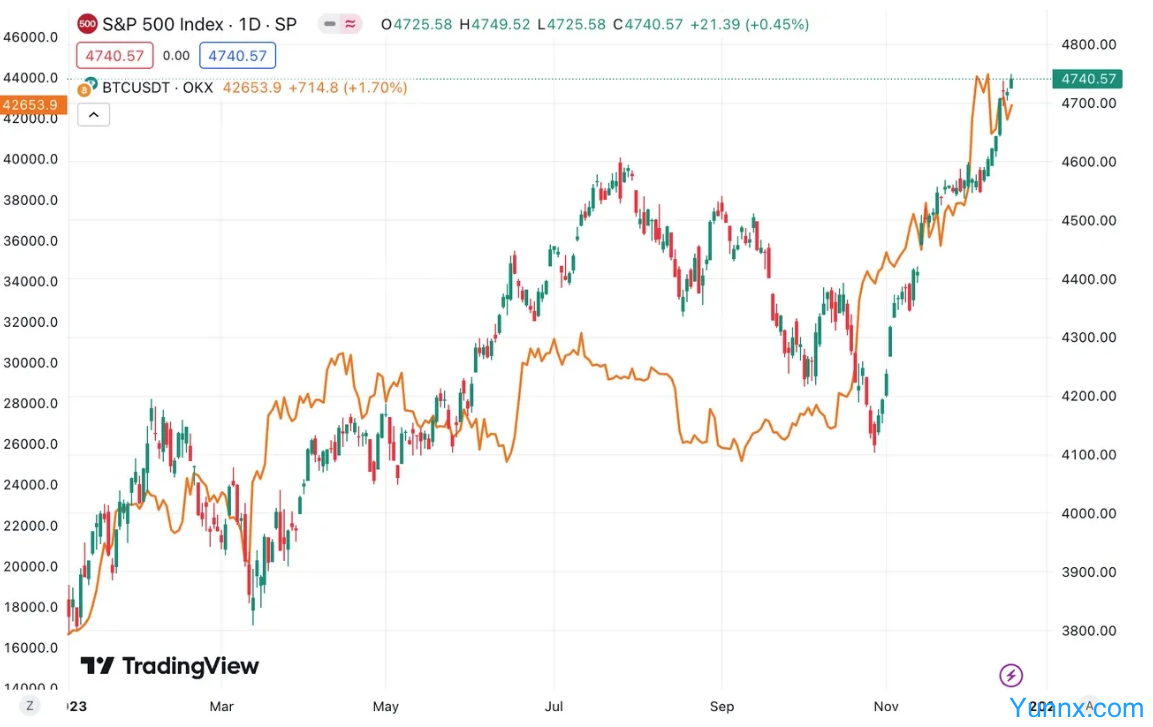Are there any correlations between Bitcoin and S&P 500 index charts and stocks?
Sep 11, 2024
However, with some hedge funds and institutions advocating for the inclusion of cryptocurrencies in portfolios, this norm is gradually shifting. With Bitcoin surging from $16,000 to over $40,000 in a year and outperforming traditional financial assets, cryptocurrencies have once again become a hot topic in the traditional finance industry.
Want to know how Bitcoin differs from S&P 500 stocks? This article will delve into comparing Bitcoin with the S&P 500, from examining Bitcoin and S&P 500 charts and measuring their year-to-date (YTD) performance, to understanding the correlation between Bitcoin and the stock market, providing you with the essential knowledge needed to compare Bitcoin with the S&P 500.
If you're a seasoned cryptocurrency user or a curious audience, you probably already know what Bitcoin is. Before diving into the comparison, let’s first understand what the S&P 500 is and why it’s so popular in traditional finance.
What is the S&P 500?
The S&P 500 Index, created in 1957, is a stock market index designed to track the performance of 500 top companies listed on U.S. stock exchanges. The components of the S&P 500 include both companies we encounter daily and high-growth tech companies, with notable examples like Tesla, Microsoft, Visa, Coca-Cola, and McDonald's.
Why is the S&P 500 so popular?
As a barometer of the U.S. economy, the S&P 500 has long been the preferred choice for risk-averse traders holding long positions. This is largely due to its time-tested nature and diversified exposure across numerous popular industries. By holding the S&P 500 long-term, traders have historically earned nearly 10% annually. In addition to its depth and diversity, the S&P 500 is also favored for its regular rebalancing. By eliminating underperforming companies and ensuring reasonable industry representation, this constant rebalancing ensures that the S&P 500 remains diverse and not overly tilted towards popular sectors like technology.
How are analysts currently viewing Bitcoin? The Evolving Bitcoin Narrative
The main reason Bitcoin and other cryptocurrencies are being discussed so frequently today is that traditional finance has finally changed its stance on the legitimacy of cryptocurrencies. Research analysts are publicly announcing that including some cryptocurrencies in your portfolio might be a good idea, a significant shift from the attitude of 2022 when Bitcoin's reputation was damaged by the collapses of Terra Luna and FTX. Today, it has evolved into a bullish narrative, with even traditional finance giants like BlackRock participating in the crypto market with Bitcoin spot ETFs.
Besides this changing narrative, Bitcoin is also gaining popularity because it is less correlated with today's macroeconomic conditions. Given Bitcoin's decentralized nature, it is now more likely than ever to be viewed as a hedge against traditional financial market volatility. This supports BlackRock CEO Larry Fink's statement that traders are seeing Bitcoin as a safe-haven asset amid local bank failures and sovereign defaults like Sri Lanka.
Similarities Between Bitcoin and the S&P 500
Strong Performance During Loose Monetary Policy
A common factor between Bitcoin and the S&P 500 is that both perform well during periods of loose monetary policy, where central banks stimulate the economy by lowering interest rates, among other measures. Such periods often lead to increased funding flowing into asset markets, making it crucial to understand why this phenomenon occurs.
During quantitative easing phases, central banks tend to purchase government bonds, injecting liquidity into the economy. This creates a low-interest-rate environment, allowing businesses and individuals to obtain loans at minimal borrowing costs. The COVID-19 pandemic is an example of this, during which businesses took advantage of near-zero interest rates and conducted significant borrowing, boosting tech companies to new highs with stocks like Peloton, Zoom, and DocuSign reaching historic peaks due to predicted demand and revenue growth. Ultimately, as companies quickly responded to favorable rates and leveraged low borrowing costs, the S&P 500 swiftly recovered from its February 2020 lows.
Similarly, Bitcoin saw traders pouring more funds into the crypto market and engaging in speculative trading due to government-issued funds and stimulus checks. This led Bitcoin to reach its historical highs before the Federal Reserve raised interest rates.
Accessibility and Convenience
Today's stock market trading is widely considered convenient and efficient. Compared to the past, when investors had to call brokers and wait for operators to assist in executing trades and getting the best price, it is a significant improvement. From accessing various markets to the commissions involved, traditional finance traders must be familiar with trading the S&P 500 index and its related stocks.
While Bitcoin was not as accessible a decade ago, cryptocurrency traders today can hold Bitcoin anytime and anywhere. With the proliferation of centralized exchanges, crypto traders can easily deposit funds and access a variety of Bitcoin-related trading pairs and derivatives like futures and options. Additionally, as spot ETFs get approved, traders will have even more ways to invest in Bitcoin.
Differences Between Bitcoin and the S&P 500
Level of Diversification
The most apparent difference between Bitcoin and the S&P 500 is that the former is a single digital asset, while the latter is a collection of 500 top U.S. companies. While trading Bitcoin provides 100% exposure to the cryptocurrency itself, trading the S&P 500 index gives exposure to a market-cap-weighted combination of various stocks, with top positions including Apple, Microsoft, and Amazon. This ultimately makes trading the S&P 500 index suitable for risk-averse traders, as it is relatively stable and diversified compared to Bitcoin.
Volatility
An important topic when comparing Bitcoin and the S&P 500 is their volatility differences. To measure this, we can look at the historical performance of Bitcoin and the S&P 500. Bitcoin's performance resembles a roller coaster, with a stark contrast between its 2022 performance and 2023 performance. From a crash of over 64% in 2022 to a 160% increase in 2023, cryptocurrency traders need to adapt to Bitcoin's volatility. In contrast, the S&P 500's annual returns have been relatively stable, averaging 9% to 10%. As it serves as a benchmark for the overall performance of the U.S. economy, its volatility is much lower. Although the S&P 500's overall returns may be lower in the same comparative period, its long-term performance is more stable based on its historical performance record.
Different Levels of Regulation
For those unfamiliar with cryptocurrencies, the regulatory differences compared to traditional finance make Bitcoin and the crypto market appear like the Wild West. Traditional finance traders have established regulatory frameworks, whereas in the cryptocurrency space, such frameworks and regulatory bodies are still evolving. Fortunately, centralized exchanges have complied with anti-money laundering standards by implementing Know Your Customer (KYC) verification requirements.
Recommend Apps











Preview: